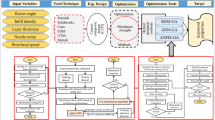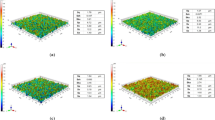Abstract
The capability to generate complex geometrical features at tight tolerances and fine surface roughness is a key element in the implementation of Creep Feed grinding process in specialist applications such as the aerospace manufacturing environment. Based on the analysis of 3D cutting forces this paper proposes a novel method of predicting the profile deviations of tight geometrical features generated using Creep Feed grinding. In this application, there are several grinding passes made at varying depths providing an incremental geometrical change with the last cut generating the final complex feature. With repeatable results from co-ordinate measurements both the radial and tangential forces can be gauged versus the accuracy of the ground features. The tangential force was found more sensitive to the deviation of actual cut depth from the theoretical one. However, to make a more robust prediction on the profile deviation its values were considered as a function of both force components (proportional to force: power was also included). For multi process, one machining platforms hole making was also investigated in terms of monitoring the force to ensure the mean cylinder was kept within required tolerances and with minimal subsequent machining (due to these imposed accuracies this is also considered a complex feature). Genetic programming (GP), an evolutionary programming technique, has been used to compute the prediction rules of part profile deviations based on the extracted radial and tangential force correlated with the said chosen “gauging” methodology (for grinding process). GP was also used to correlate the force and flank wear (VB) for hole deviations. It was found that using this technique, complex rules can be achieved and used online to dynamically control the geometrical accuracy of ground and drilled hole features. The GP complex rules are based on the correlation between the measured forces and recorded deviation of the theoretical profile (both grinding and hole making). The mathematical rules are generated from Darwinian evolutionary strategy which provides the mapping between different output classes. GP works from crossover recombination of different rules and the best individual is evaluated in terms of the given ‘best fitness value so far’ which closes on an optimal solution. The best obtained GP terminal sets were realised in rule-based embedded coded systems which were finally implemented into a real-time Simulink simulation. This realisation gives a view of how such a control regime can be utilised within an industrial capacity. Neural networks were used for GP decision verification ensuring less sensitivity to possible outliers giving more robustness to the integrated system.


























Similar content being viewed by others
References
Agustina, B., Rubio, E. M., & Sebastián, M. A. (2014). Surface roughness model based on force sensors for the prediction of the tool wear. Sensors, 14, 6393–6408.
Arvajeh, T., & Ismail, F. (2006). Machining stability in high speed drilling—Part 2: Time domain simulation of a bending-torsional model and experimental validations. International Journal of Machine Tools & Manufacture, 46, 1573–1581.
Chen, X., & Rowe, W. B. (1999). Modelling surface roughness improvement in grinding. Proceedings of the Institution of Mechanical Engineers Part B-Journal of Engineering Manufacture, 213(1), 93–96.
DeHart, A., & Murphy, D. (2004). Machine shopping: How to become a better-informed machine tool consumer, American Machinist. http://americanmachinist.com/machining-cutting/machine-shopping.
Furness, R. (1992). Supervisory Control of the Drilling Process, Ph.D. dissertation. Department of Mechanical Engineering and Applied Mechanics, University of Michigan.
Furness, R. J., Tsao, T. C., Rankin, J. S., Muth, M. J., & Manes, K. W. (1999). Torque control for a form tool drilling operation. IEEE Transactions on Control Systems Technology, 7(1), 22–30.
Griffin, J., & Chen, X. (2014, February). Real-time Neural Network classifications of characteristics from emitted Acoustic Emission during Horizontal Single Grit Scratch Tests. Journal of Intelligent Manufacturing, 1–17.
Haber, R. E., Gajate, A., Liang, S. Y., Haber, R. H., & del Toro, R. M. (2011). An optimal fuzzy controller for a high-performance drilling process implementation over and industrial network. International Journal of Innovative Computing, Information and Control, 7(3), 1481–1498.
Hekman, K. A., & Liang, S. Y. (1998a). Feedrate optimization and DOC control for productivity and parallelism in grinding. Mechatronics, 9, 447–462.
Hekman, K. A., & Liang, S. Y. (1998b). Flatness control in grinding by depth of cut manipulation. Mechatronics, 8(4), 323–335.
Howard, D., & Roberts, S. C. (1999a). Target detection in SAR imagery by genetic programming. Advances in Engineering Software, 30(5), 303–311.
Howard, D., & Roberts, S. C. (1999b). Evolution of ship detectors for satellite SAR imagery. Genetic Programming, 1598, 135–148.
Howard, D., & Roberts, S. C. (2006). Pragmatic Genetic Programming strategy for the problem of vehicle detection in airborne reconnaissance. Pattern Recognition Letters, 27(11), 1275–1288.
Jemielniak, K., Kwiatkowski, L., & Wrzosek, P. (1998). Diagnosis of tool wear based on cutting forces and acoustic emission measures as inputs to a neural network. Journal of Intelligent Manufacturing, 9, 447–455.
Kim, J. B., Lee, S. J., & Park, Y. P. (1994). Stable and efficient drilling process by active control of the thrust force. Mechanical Systems and Signal Processing, 8(5), 585–595.
Kruger, M., & Denkena, B. (2013). A model-based approach for monitoring of shape deviations in peripheral milling. International Journal of Advanced Manufacturing Technology, 67, 2537–2550.
Kurfess, T. R., & Whitney, D. E. (1992). Predictive control of a robotic grinding system. Journal of Engineering for Industry, 114(4), 412–20.
McCulloch, W. S., & Pitts, W. H. (1943). A logical calculis of the ideas immanent in nervous activity. Bulletin of Mathematical Biophysics, 5, 115–133.
Oh, Y. T., Kim, G. D., & Chu, C. N. (2003). Design of a drilling torque controller for a machining center. International Journal of Advanced Manufacturing Technology, 22(5–6), 329–335.
Ozel, T., & Karpat, Y. (2005). Predictive modelling of surface roughness and tool wear in hard turning using regression and neural networks. International Journal of machine Tools & Manufacture, 45, 467–479.
Pratap, S., Daultani, Y., Tiwari, M.K., & Mahanty, B. (2015). Rule based optimization for a bulk handling port operations. Journal of Intelligent Manufacturing, 1–25.
Razavi, H. A., & Kurfess, T. R. (2001). Force control grinding of gamma titanium aluminide. International Journal of Machine Tools & Manufacture, 43, 185–191.
Ren, Q., Balazinski, M. & Baron, L. (2012). Fuzzy Identification of Cutting Acoustic Emission with Extended Subtractive Cluster Analysis. Nonlinear Dynamics, 67(4), 2599–2608.
Ren, Q., Balazinski, M., Jemielniak, K., Baron, L. & Achiche, S. (2013) Experimental and Fuzzy Modelling Analysis on Dynamic Cutting Force in Micro Milling. Soft Computing, 17, 1687–1697.
Ritou, M., Garnier, S., Furet, B., & Hascoët, J. -Y. (2014). Angular approach combined to mechanical model for tool breakage detection by eddy current sensors. Mechanical Systems and Signal Processing, 44(1–2), 211–220.
Sharma, V., Dhiman, S., Sehgal, R., & Sharma, S. (2008). Estimation of cutting forces and surface roughness for hard turning using neural networks. Journal of Intelligent Manufacturing, 8, 215–226.
Sheng, Y., & Tomizuka, M. (2006). Intelligent modeling of thrust force in drilling process. Journal of Dynamic Systems Measurement and Control-Transactions of the ASME, 128(4), 846–855.
Sick, B. (2002). On-line and indirect tool wear monitoring in turning with artificial neural networks: A review of more than a decade of research. Mechanical Systems and Signal Processing, 16, 487–546.
Silva, S., & Tseng, Y. T. (2005). Classification of Seafloor Habitats using Genetic Programming. In GECCO’05. Washington.
Silva, S. (2004). A genetic programming toolbox for Matlab—version 2. ECOS—Evolutionary and Complex Systems Group, University of Coimbra, Portugal. http://gplab.sourceforge.net/.
Srivastava, A. K., & Elbestawi, M. A. (1995). Control strategy for mutlipass robotic grinding. International Journal of Robotics and Automation, 10(3), 114–119.
Thoma, S., & Weikert, S. (2012). Compensation strategies for axis coupling effects. In 5th CIRP Conference on High Performance 2012 (vol. 1, pp. 255–259).
Ulsoy, A. G., & Koren, Y. (1993). Control of machining processes. Journal of Dynamic Systems, Measurement, and Control, 115, 301–308.
Upton, D. P. (2000). Optimization of cutting fluid performance. International Journal of Production Research, 38(5), 1219–1223.
Venkatesh, K., Zhou, M., & Caudill, R. (1997). Design of neural networks for tool wear monitoring. Journal of Intelligent Manufacturing, 8, 215–226.
Warnecke, G., & Kluge, R. (1998). Control of tolerances in turning by predictive control with neural networks. Journal of Intelligent Manufacturing, 9, 281–287.
Xiaoli, L., Yingxue, Y., & Zhejun, Y. (1997). On-line tool condition monitoring system with wavelet fuzzy neural network. Journal of Intelligent Manufacturing, 8, 271–276.
Yoo, S. M. (1990). Computer simulation of the flexible disk grinding process: flat surface control using variable vertical feed speed. In Symposium on monitoring and control for manufacturing processes. ASME WAM PED (Vol. 44, pp. 123–32).
Acknowledgments
The authors are grateful to The University of Nottingham for their valuable technical support during the experimental investigation. Please also note that the experimental work was carried out at The University of Nottingham. The Grant for carrying out this work was awarded by The University of Nottingham Doctoral Awards.
Author information
Authors and Affiliations
Corresponding author
Rights and permissions
About this article
Cite this article
Griffin, J.M. The prediction of profile deviations from multi process machining of complex geometrical features using combined evolutionary and neural network algorithms with embedded simulation. J Intell Manuf 29, 1171–1189 (2018). https://doi.org/10.1007/s10845-015-1165-y
Received:
Accepted:
Published:
Issue Date:
DOI: https://doi.org/10.1007/s10845-015-1165-y




